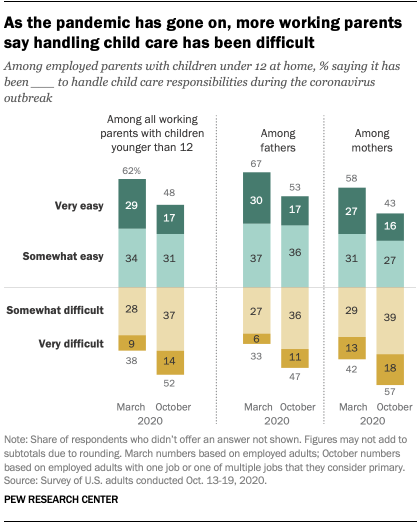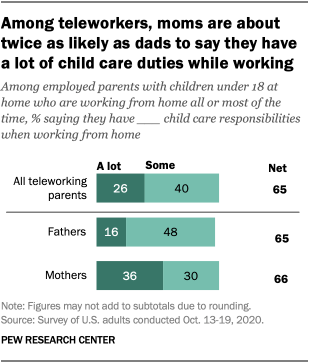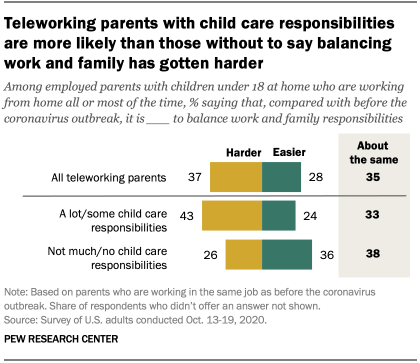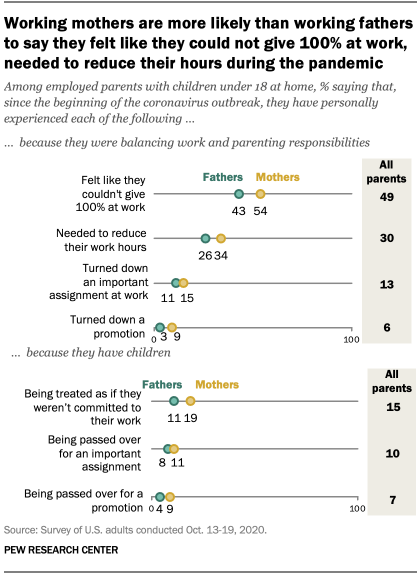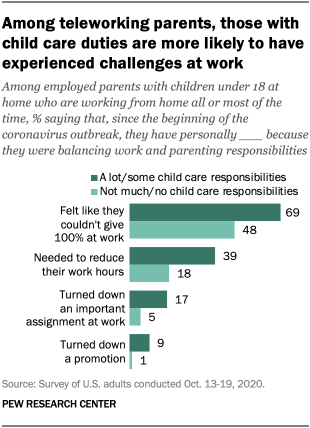
The coronavirus outbreak has changed the way many Americans work, and for employed parents, in particular, the pandemic has brought additional challenges as many schools and child care facilities remain closed.
Over the course of the pandemic, there has been an increase in the share of working parents who say it is difficult to handle child care responsibilities. At the same time, many working parents have experienced professional challenges while trying to balance their work and family responsibilities, according to a new analysis of a Pew Research Center survey conducted in October 2020.
Overall, about half of employed parents with children younger than 12 in the household (52%) say it has been difficult to handle child care responsibilities during the coronavirus outbreak, up from 38% who said this in March 2020.
Both working mothers and fathers with children younger than 12 are more likely than they were earlier in the pandemic to say it’s been difficult to handle child care responsibilities. But as was the case in March, larger shares of mothers than fathers say this (57% vs. 47%).
Pew Research Center conducted this study to better understand the experiences of employed parents during the coronavirus outbreak and how those experiences may have changed since before the pandemic. This analysis is based on 2,029 U.S. adults who have children younger than 18, are working part time or full time, and either have one job or have more than one job but consider one to be primary. The data was collected as a part of a larger survey conducted Oct. 13-19, 2020. Everyone who took part is a member of the Center’s American Trends Panel (ATP), an online survey panel that is recruited through national, random sampling of residential addresses. This way, nearly all U.S. adults have a chance of selection. The survey is weighted to be representative of the U.S. adult population by gender, race, ethnicity, partisan affiliation, education and other categories. Read more about the ATP’s methodology.
Here are the questions used for this report, along with responses, and its methodology.
References to parents refer to those who are parents or guardians of children under age 18 in the household unless otherwise specified.
References to workers or employed adults include those who are employed part time or full time and who have only one job or have more than one job but consider one of them to be their primary job.
Among working parents who are married or cohabiting, child care responsibilities are more challenging for those who have a spouse or partner who is also employed. Around half of these parents (53%) say handling child care has been difficult, compared with 42% of working parents who have a spouse or partner who is not employed. (There were not enough working parents who are neither married nor living with a partner in the sample to analyze this group separately.)
Amid pandemic-related school and day care closures, many working parents are juggling child care duties while they work. Among employed parents who are working remotely all or most of the time and have children younger than 18 at home, about two-thirds (65%) say they have at least some child care responsibilities when working from home, including 26% who say they have a lot.
Mothers and fathers who are working from home all or most of the time are equally likely to say they have at least some child care responsibilities while working from home (66% vs. 65%), though moms are about twice as likely as dads to say they have a lot of these duties (36% vs. 16%).
Child care responsibilities during the workday vary depending on the age of the children in the home. Parents who are working from home all or most of the time and who have at least one child who is preschool age or younger are more likely than those with only school-age children to say they have at least some child care responsibilities while working (77% vs. 59%).
To be sure, not all working parents have the ability to work remotely. Some 43% of employed parents say they have jobs that can be done from home, while 57% say their jobs cannot be done remotely. Of those who have the option, roughly seven-in-ten (72%) say they are, in fact, working from home all or most of the time.
Working moms more likely than working dads to say work-family balance has gotten harder
For many working parents, balancing work and family responsibilities is harder than it was before the coronavirus outbreak. A third of employed parents who have the same job as before the pandemic and have children under age 18 (whether at home or not) say that, compared with before the outbreak, it has been harder to balance work and family responsibilities, while 13% say it has become easier and 53% say things are about the same. Working moms are more likely than working dads to say it’s become harder (39% vs. 28%).
Teleworking seems to have helped some working parents for whom it is an option: Around three-in-ten working parents who are teleworking all or most of the time (28%) say their work-family balance has gotten easier, compared with 11% of those who are teleworking only some of the time, rarely or not at all – and just 6% of those who say their job can’t be done from home.
Still, among teleworking parents, those with children under 18 at home and at least some child care duties during the workday are especially likely to say balancing work and family has gotten harder: 43% of these parents say this, compared with 26% of teleworking parents who have few or no child care duties while working remotely.
Parents who are teleworking are also having a harder time getting their work done without interruptions: Half of parents who are working from home all or most of the time say it has been somewhat or very difficult.
It is a particular challenge for teleworking parents with children under 18 at home and who have child care duties while working from home. About six-in-ten of these parents (63%) say it’s been difficult for them to get their work done without interruptions since the pandemic started. This compares with only 24% of teleworking parents who don’t have much or any child care duties while working.
The public seems to recognize the additional challenges that the pandemic is posing for working parents. More than eight-in-ten U.S. adults (83%) think it’s fair that some companies have given working parents additional time off to deal with disruptions caused by the coronavirus outbreak because parents are dealing with demands at home that other workers don’t have; just 16% say this is unfair because workers who don’t have children end up having to do more work. Among employed adults, large shares of those who have children younger than 18 (86%) and those who do not (80%) say it’s fair that some companies have given working parents additional time off.
Working moms are more likely than working dads to face certain professional challenges
When asked about some of the specific challenges they may have faced at work since the beginning of the coronavirus outbreak because they were balancing work and parenting responsibilities, roughly half of employed parents (49%) say they felt like they could not give 100% at work since the outbreak began and 30% say they needed to reduce their work hours. Fewer say they have turned down an important work assignment (13%) or a promotion (6%).
Some 15% say they have been treated as if they weren’t committed to their work because they have children, while 10% say they have been passed over for an important assignment for this reason and 7% say they have been passed over for a promotion.
For the most part, mothers are more likely than fathers to say they have had each of these experiences since the beginning of the coronavirus outbreak. For example, 54% of working moms say they felt like they could not give 100% at work, compared with 43% of working dads.
These patterns and gender differences mirror those found in a survey conducted in the summer of 2019 – long before the coronavirus outbreak – when working parents were asked if these things had ever happened to them.
Parents who are teleworking all or most of the time and who have at least some child care duties while at work are more likely than teleworking parents who have little or no child care duties during the workday to say they have experienced these things. For example, 69% of teleworking parents with at least some child care duties say they have felt they couldn’t give 100% at work, compared with 48% of teleworking parents with not much or no child care duties.
Among those who have child care responsibilities while working from home, mothers are more likely than fathers to say they have needed to reduce their work hours (50% vs. 30%), have been treated as if they weren’t committed to their work (22% vs. 13%), have been passed over for a promotion (13% vs. 3%) or have turned down a promotion (13% vs. 5%).
CORRECTION (Oct. 11, 2021): This post has been updated to reflect that 80% of employed adults who do not have children younger than 18 say it’s fair that some companies have given working parents additional time off. This change does not affect the study’s substantive findings.
Note: Here are the questions used for this report, along with responses, and its methodology.
